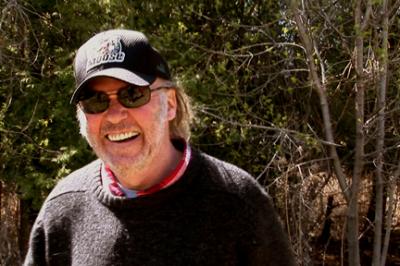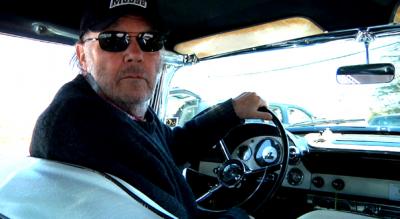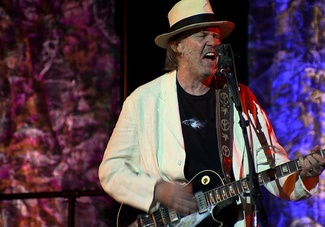By: debbie lynn elias
When you toss out the name Neil Young, my interest is peaked. Toss out the name of Jonathan Demme, and you’ve got more than my attention. Put them both together and we’re talking a “Must See” project, no matter what it is. And that’s just what Oscar winner Jonathan Demme and Oscar nominee/Grammy winner Neil Young bring us with NEIL YOUNG JOURNEYS.
You know the old adage, the third time’s a charm? Well, this third pairing between director Jonathan Demme and Young, following up Neil Young Trunk Show in 2009 and Neil Young: Heart of Gold in 2006, is pure magic. While prior documentaries by not only Demme, but other directors who have captured Young on film, including Neil Young himself, have been interesting, they were never as revealing or personal as JOURNEYS. This is the first time that I have watched a documentary on Neil Young and walked away feeling like I had a sense of who this man is personally. So revealing is JOURNEYS that at times one gets a sense that we are seeing two entirely different people: one, the brooding, intense balladeer and the other, a Neil Young who is carefree with a boyish charm as he winds his way through his hometown of Omemee, Ontario.
I had a chance to ask Demme about the development of NEIL YOUNG JOURNEYS and how it became something so personal and intimate. Of course, serendipity is at the heart of it. Describing Young as an “actively cinematic person” and the fact that every aspect of his person “lends itself to the camera” was the starting point. “Given that so many of Neil’s songs are autobiographical in nature, one way or the other, the song cycle for the Le Noise Tour, which is what we filmed, seemed especially autobiographical. The new songs are very much about what he’s feeling right now, as is often the case, and also, the older songs are songs he felt passionate about. So here we are on the last night of this solo tour – the first time this man has toured without a band in ages – and it’s back in his home town in Toronto. It’s back at Massey Hall. The previous time he was there was when he was emerging, back in the 70’s I guess, emerging, ‘local boy makes good.’ Now, he’s this grizzled maestro who’s going to be back at this place and we’re very close to [Omemee] and I thought there’s an opportunity here to maybe get Neil to open up in a way that can inform, reference the nature of these songs, and give us some oxygen in a film that’s going to be very intense because so many of the songs are so wonderfully intense. So, that’s kind of what resulted in the idea of putting Neil in a car where he feels obviously, very at home. And that’s kind of it.

Endearing, is that we see Young’s face lights up with mischievous little smiles when regaling some of his boyhood escapades, and then gets wistful as he recalls fishing or people and places that are long gone. There is an overall “light” and “lightness” to him that is welcoming, amiable and very opening and welcoming. For Demme, this was an unexpected, untapped gold mine. “When we got to Toronto the week leading up to the concert and I found that we were only 3 hours from Omemee, I thought it would be stupid to not go up there if Neil would be willing to go. I didn’t think we needed a dimension like that, but I thought that maybe something special will happen under those circumstances; and especially given the fact that Neil is an obsessive vintage car [guy]. He collects them, he has dozens of cars and he used to have more. They’re all from the 50’s or 60’s and older. So the idea of the town in North Ontario, an old car, a drive to the concert – I didn’t know how we could use it, but that could have editing potential. So, he was like, ‘Sure. Why not!’ Now, did I have any clue that he would start coming forth with these extraordinary little anecdotes like blowing up turtles and things like that? Noooo. But I was really delighted as that was happening. I thought, ‘Gee, we might have something here.’” The end result is more than “something.” With Young’s narrative trip down memory lane during the drive around town, you feel like you’re just one of his friends chatting as you go on a hometown sightseeing drive down memory lane.

And then there is the intimate and incredible concert footage of Young. Shooting in the famed Massey Hall, acoustics are already as good as it gets, but how does one engage the audience visually with just one man on this small intimate stage setting. The answer is tap into the collaborative vision of cinematographer Declan Quinn and Demme. “Declan and I kinda talk theoretically and then he’s the one who goes out there and really sets the cameras and makes sure the lighting is going to be gorgeous. Here, it was very interesting because with this film – the two previous films that we filmed with Neil, he was working with, first, a big band. He had a lot of fellow musicians in Neil Young Heart of Gold. And Neil Young Trunk Show he still had like 7 people on stage with him. Part of what we were able to capitalize on to make those films really engaging in a big way . . . [was] we really shot in order to capitalize on the relationships between Neil and the people he was playing with. That’s how we picked our angles.

But what happens when that cornerstone of activity isn’t available. For Demme and Quinn, you work with what you have. “What we can do is tie him in now more than ever before with the songs, the stories he’s telling. And we can actually dedicate a camera to his guitar. We can have to dedicated close-ups that can be beautiful and we’ll pick just the right spot. We can have a dedicated full figure, and we still have other places. So now we’re covered in these ways. So Declan took these things that are called ICON cameras, they’re like this big (finger framing about 2 inches), and attach them to different places and put them like riiiight here (motioning inches from the face) on the piano, right on the music stand, so you’re like right there; a place where you could never put a real camera. And then there’s that shot that I’m sure you noticed, an angle that’s so in his face that it can’t even cover or hold his entire face and it becomes shot of his mouth, the portal of the songs and the voice. He screwed one of these on because Declan wanted to get, it was such a great idea, he wanted to get a close-up of a singer that didn’t have a microphone in the foreground. . . He put the camera on that and it was supposed to be the full face. [But] the screw loosened a little bit during the set, dipped down and Declan and I go racing backstage to see what we got on the ICON when the show’s over. And Declan was like, “Oh God! This is a disaster!” And I said, “No, it’s not. This is something that we never could have planned” and we used it in two very specific songs, two deranged songs, the deranged angle, the deranged songs. . .What we want to do is film it in such a way so that we can bring the audience as close as is humanly possible to the stories and to Neil, to get inside these songs.”

Leaving one breathless, the end result of NEIL YOUNG JOURNEYS is not only a powerfully lensed, but beautifully lensed film. Thanks to Declan Quinn, the power of the camera – all 10 of them, “6 operated cameras and 4 of the ICONS”, the melding of close-ups, 8mm, 16mm, digital, skewed angles and focusing, all visually blend with the same power and beauty as the notes of music Young has put together into song. And there are no words to adequately describe use of lighting and framing during the concert which is magical – especially a triangular framing of a shot of Young while at the organ. With every note, every word, every frame, Demme and Young will have you mesmerized.
The real achievement comes from Glenn Allen’s editing which attains a perfect balance between the man and the myth, allowing us to meet and greet, Neil Young – a little boy from Omemee.
Perhaps one of the best “concert” documentaries ever made, NEIL YOUNG JOURNEYS is one journey you don’t want to miss.
Neil Young
Directed by Jonathan Demme.











